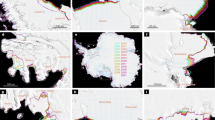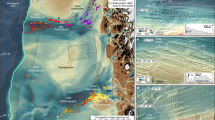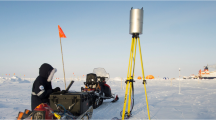Coastlines concealed in polar seas are now more accessible to cartography.
Abstract
Tobias Island, discovered in 1993 by the German research vessel RV Polarstern, is a system of low-lying banks and shoals hidden in sea ice 70 km off the northeastern coast of Greenland. Here we use satellite radar interferometry and airborne laser scanning to show that this island is 2 km long and 35 m high — much larger than was originally reported1. We have also been able to pinpoint the exact location of a stable area where a new group of small islands may be hidden. This demonstrates that satellite radar interferometry is an effective tool for finding ice-covered islands as well as for mapping them.
Similar content being viewed by others
Main
Tobias Island was only recently discovered because it is remote and is permanently surrounded by sea ice, and conditions there are frequently foggy and cloudy. Satellite radar is ideal for the investigation of such areas as it is independent of daylight and is able to 'see' through clouds. Satellite radar interferometry relies on the comparison of two images2, allowing changes in the propagation path length from the satellite to the terrain to be detected with an accuracy of a fraction of a wavelength. The radar echo in one pixel is the sum of the echoes from many small scatterers. The terrain thus needs to be stable to ensure that a phase change in the reflected radar signal is caused by different propagation delays, and not simply by a change or rearrangement in the radar echoes from all of the small scatterers. For the European Remote Sensing Satellite 1/2 (ERS-1/2) radar data used here, the wavelength is 5.7 cm and images with a time separation of 1 or 3 days are combined.
The most obvious way to find new islands is to search for areas that have high interferometric radar correlation. This would indicate bare rocks and, in periods without melt events, snow-covered islands, stranded sea-ice floes and icebergs, and shore-fast sea ice. Drifting sea ice and open-water areas do not generate any correlation. It is more difficult to discriminate between shore-fast ice, stranded ice and land, all of which potentially reveal a high correlation.
We make use of the constant phase given by land and stranded ice, as opposed to the varying phase found in images from shore-fast sea ice that has been displaced by the tide and deformed by wind stress. A low-correlation flexure zone separates stranded and floating ice; a time series is required to differentiate land from stranded ice. Correlation and phase images can therefore be used to detect island candidates and to define the maximum extent of their coastlines.
Our analysis of radar data from an area (100 × 100 km) east of the Nioghalvfjerdsfjorden glacier clearly showed Tobias Island, but did not reveal any other bare rock islands (Fig. 1). However, inspection of interferograms from a time series of radar data acquired between December 1991 and May 1998 revealed that Tobias Island is associated with a very stable feature, which measures 0.8 × 2.0 km and is located 8 km to the southeast. We interpret this feature as either a group of islands or an area of very shallow water. It could also be a stranded iceberg, but this is less likely as its shape remained stable throughout the observation period. The radar images consistently show the presence of sea ice around Tobias Island and the 'new' islands, even during a period of break-up closer to the coast, a finding that is consistent with the idea that the semi-permanent ice cover to the south and west of Tobias Island is caused by ice adhering to various obstacles.
a, Map of the area (red square on inset map) showing the location of the islands off the northeastern coast of Greenland. b, Elevation map of Tobias Island obtained from scanning airborne laser altimetry (dotted overlay) and radar interferometry (5-m height-contour intervals). c, Interferometric radar correlation between two data sets obtained on 4 and 5 September 1996. Grey intensity denotes degree of correlation: black, no correlation; white, full correlation. d, Colour-coded interferometric phases: these are constant for land and grounded ice, but vary for floating ice. Tobias Island is located at 79° 20.3′ N 15° 48.2′ W; the new small islands are at 79° 15.2′ N 15° 33.6′ W (centre of circles, World Geodetic System 1984). Radar maps are presented in Universal Transversal Mercator projection, zone 27, with lower-left corners at 600 km east, 8,800 km north.
Satellite radar interferometry can pinpoint a location very accurately3, allowing the location to be investigated further by conventional fieldwork. For example, airborne laser altimetry was used to map Tobias Island in April 2001, in connection with the first fixed-wing aircraft landing there. Similar measurements are planned for May 2002 to verify the existence of the new islands.
References
Sørensen, K. in Geology of Greenland Survey Bulletin (eds Dawes, P. R. & Higgins, A. K.) 186, 7–10 (Geol. Surv. Denmark Greenland, Copenhagen, 2000).
Massonnet, D. & Feigl, K. Rev. Geophys. 36, 441–500 (1998).
Mohr, J. J. & Madsen, S. N. IEEE Trans. Geosci. Remote Sensing 39, 842–850 (2001).
Author information
Authors and Affiliations
Corresponding author
Ethics declarations
Competing interests
The authors declare no competing financial interests.
Rights and permissions
About this article
Cite this article
Mohr, J., Forsberg, R. Searching for new islands in sea ice. Nature 416, 35 (2002). https://doi.org/10.1038/416035a
Issue Date:
DOI: https://doi.org/10.1038/416035a
This article is cited by
-
Long-term chlorophyll-a dynamics in tropical coastal waters of the western Bay of Bengal
Environmental Science and Pollution Research (2020)
-
Status of the endangered ivory gull, Pagophila eburnea, in Greenland
Polar Biology (2009)
Comments
By submitting a comment you agree to abide by our Terms and Community Guidelines. If you find something abusive or that does not comply with our terms or guidelines please flag it as inappropriate.




